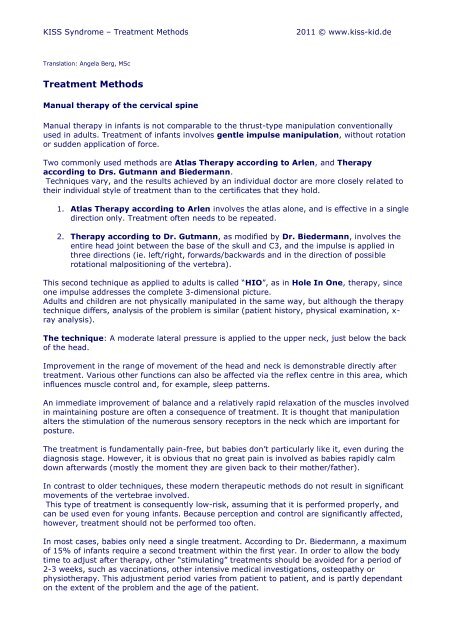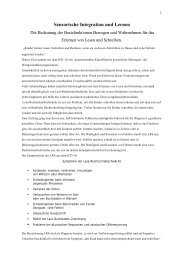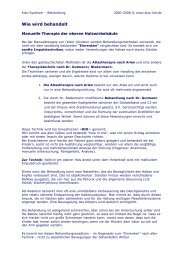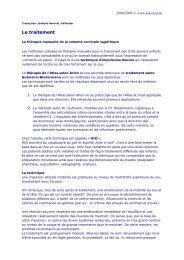Treatment Methods - KISS-Kid
Treatment Methods - KISS-Kid
Treatment Methods - KISS-Kid
Create successful ePaper yourself
Turn your PDF publications into a flip-book with our unique Google optimized e-Paper software.
<strong>KISS</strong> Syndrome – <strong>Treatment</strong> <strong>Methods</strong><br />
2011 © www.kiss-kid.de<br />
Translation: Angela Berg, MSc<br />
<strong>Treatment</strong> <strong>Methods</strong><br />
Manual therapy of the cervical spine<br />
Manual therapy in infants is not comparable to the thrust-type manipulation conventionally<br />
used in adults. <strong>Treatment</strong> of infants involves gentle impulse manipulation, without rotation<br />
or sudden application of force.<br />
Two commonly used methods are Atlas Therapy according to Arlen, and Therapy<br />
according to Drs. Gutmann and Biedermann.<br />
Techniques vary, and the results achieved by an individual doctor are more closely related to<br />
their individual style of treatment than to the certificates that they hold.<br />
1. Atlas Therapy according to Arlen involves the atlas alone, and is effective in a single<br />
direction only. <strong>Treatment</strong> often needs to be repeated.<br />
2. Therapy according to Dr. Gutmann, as modified by Dr. Biedermann, involves the<br />
entire head joint between the base of the skull and C3, and the impulse is applied in<br />
three directions (ie. left/right, forwards/backwards and in the direction of possible<br />
rotational malpositioning of the vertebra).<br />
This second technique as applied to adults is called “HIO”, as in Hole In One, therapy, since<br />
one impulse addresses the complete 3-dimensional picture.<br />
Adults and children are not physically manipulated in the same way, but although the therapy<br />
technique differs, analysis of the problem is similar (patient history, physical examination, x-<br />
ray analysis).<br />
The technique: A moderate lateral pressure is applied to the upper neck, just below the back<br />
of the head.<br />
Improvement in the range of movement of the head and neck is demonstrable directly after<br />
treatment. Various other functions can also be affected via the reflex centre in this area, which<br />
influences muscle control and, for example, sleep patterns.<br />
An immediate improvement of balance and a relatively rapid relaxation of the muscles involved<br />
in maintaining posture are often a consequence of treatment. It is thought that manipulation<br />
alters the stimulation of the numerous sensory receptors in the neck which are important for<br />
posture.<br />
The treatment is fundamentally pain-free, but babies don’t particularly like it, even during the<br />
diagnosis stage. However, it is obvious that no great pain is involved as babies rapidly calm<br />
down afterwards (mostly the moment they are given back to their mother/father).<br />
In contrast to older techniques, these modern therapeutic methods do not result in significant<br />
movements of the vertebrae involved.<br />
This type of treatment is consequently low-risk, assuming that it is performed properly, and<br />
can be used even for young infants. Because perception and control are significantly affected,<br />
however, treatment should not be performed too often.<br />
In most cases, babies only need a single treatment. According to Dr. Biedermann, a maximum<br />
of 15% of infants require a second treatment within the first year. In order to allow the body<br />
time to adjust after therapy, other “stimulating” treatments should be avoided for a period of<br />
2-3 weeks, such as vaccinations, other intensive medical investigations, osteopathy or<br />
physiotherapy. This adjustment period varies from patient to patient, and is partly dependant<br />
on the extent of the problem and the age of the patient.
After this pause, physiotherapy needs can be evaluated, and where necessary adjusted to suit<br />
the current developmental stage of the patient.<br />
A routine check-up is advisable when the child reaches three years of age, and again before<br />
starting school. This allows for early identification of poor motor skills or perception problems,<br />
avoiding the risk of oversight during normal medical checkups.<br />
Brief relapses, for example during an infection or a growth spurt, do not require a new visit to<br />
the specialist. It may be that a child falls back into old habits for a short period.<br />
Once freedom of movement has been established, the child’s body is usually able to cope with<br />
minor challenges. After major falls or anasthaesia it may be sensible to have a checkup, if<br />
symptoms recur and persist for longer than 1-2 weeks.<br />
Babies from families with a history of spinal problems such as scoliosis should be regularly<br />
monitored. This can usually be achieved via a physiotherapist and general practitioner, so that<br />
visits to the specialist can be restricted to 1-2 times per year.<br />
Manual therapy does not replace other forms of therapy, but provides a starting point from<br />
which occupational therapy (Ergotherapie), physiotherapy, INPP therapy or psychomotor<br />
therapy can be provided more efficiently. Manual therapy optimizes biomechanics (joint and<br />
muscle function) and central control.<br />
Manual therapy of the head and neck for adults<br />
<strong>Treatment</strong> of older children and adults takes longer, because the vertebrae are usually fixed<br />
into their positions and not so open to re-setting. Again, it is again important to avoid using<br />
manual therapy too frequently, since the body’s response to an improved head joint position<br />
needs time and patience. Daily treatments have now been abandoned by most atlas<br />
therapists. Depending on the diagnosis, the time between treatments may be several weeks to<br />
months.<br />
In addition to corrections to the head joint, the pelvic joint and the rest of the spinal column<br />
are assessed and treated as necessary. Various techniques may be used, for example<br />
osteopathy, particularly “soft tissue techniques” such as myofascial release or muscle energy<br />
technique.<br />
Manual therapy of the cervical spine can help with:<br />
<br />
<br />
<br />
<br />
<br />
<br />
<br />
<br />
Neck pain<br />
Whiplash<br />
Dizziness<br />
Balance problems<br />
Movement difficulties (spasticity, Parkinsons)<br />
Chronic backache<br />
Slipped discs<br />
Ringing in the ears (tinitus)<br />
A routine examination of the head joint in babies (as is carried out for the hip joint) could<br />
potentially help very many people in reducing headaches, back pain and even certain<br />
behavioural problems in later life.<br />
The time-consuming nature of investigation and treatment means that many doctors working<br />
in this area only treat private patients. Whether public health insurers cover treatment, and to<br />
what extent, is often a question of negotiation.





